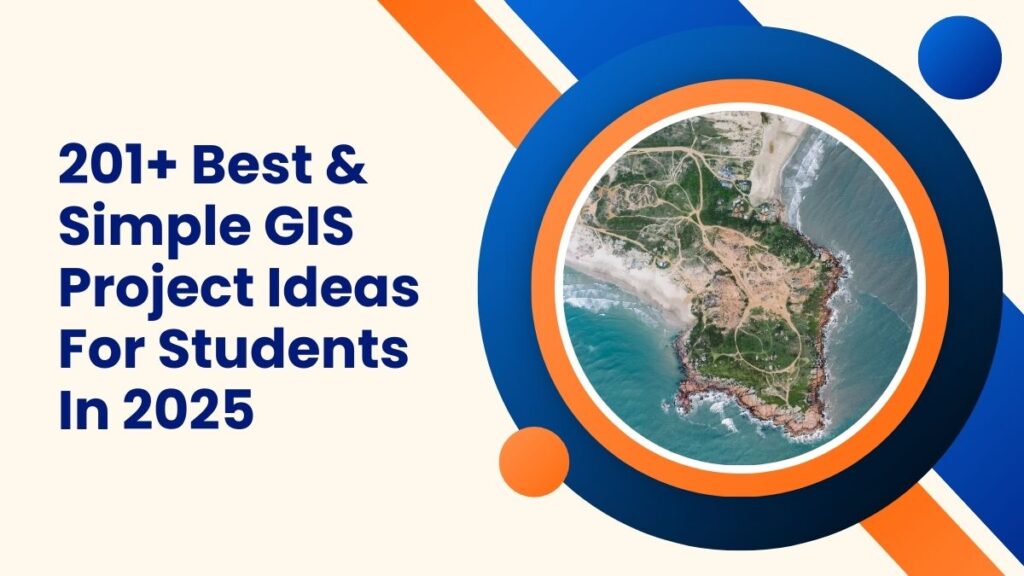Check out fun GIS project ideas for students! Learn about mapping, analyzing data, and exploring your environment. Great for beginners and anyone interested in geographic information systems!
Have you ever thought about how maps can help us understand our world? Geographic Information Systems, or GIS, are tools that let us collect and look at information about places. They help with things like tracking climate change and planning cities.
For instance, the Environmental Protection Agency (EPA) says GIS can help find pollution sources and improve health. In schools, students use GIS to do projects that help their communities. Whether mapping local parks or studying traffic, these projects teach students important skills while solving real problems.
In this blog, we’ll look at fun GIS project ideas for students. These projects will be enjoyable and educational. Let’s explore the world of GIS and see how you can use maps to make a difference!
Simple GIS Project Ideas For Students PDF
What is GIS?
GIS, or Geographic Information System, is a tool that helps us collect, analyze, and display data related to locations. It combines maps with information about places to help us understand patterns and trends in the environment. GIS can create detailed maps, analyze geographic information, and support decision-making in areas like city planning, environmental studies, transportation, and public health.
Importance of GIS Projects for Students
Here are the importance of GIS project for students:
Hands-On Experience
GIS projects give students practical experience with important tools and methods, allowing them to apply what they’ve learned in school to real-life situations.
Problem-Solving Skills
Working on these projects helps students think critically and solve problems. They learn to analyze data and come up with solutions based on their findings.
Learning Across Subjects
GIS projects often require knowledge from different areas, such as geography, science, and technology, helping students see how different fields connect.
Job Readiness
Knowing how to use GIS tools and techniques can make students more appealing to employers in fields like city planning, environmental management, and public health.
Helping Communities
Many GIS projects focus on local issues, allowing students to make a positive impact in their communities by analyzing problems and suggesting improvements.
Understanding Data
Students learn how to collect, manage, and analyze data, which is important in today’s world where data is everywhere.
Visual Communication
GIS teaches students how to present complex information in a visual way, making it easier to share their findings with different audiences.
By participating in GIS projects, students gain useful skills that apply to many areas while also helping with important community and environmental issues.
Steps For Choosing The Good GIS project ideas For Students
These are the steps, you can choose a GIS project that is interesting and easy to manage, making it a great learning experience:
| Tip | Description |
|---|---|
| Find What You Like | Think about topics you enjoy, like nature, city planning, health, or history. Pick something you care about. |
| Know Your Audience | Decide who will benefit from your project. Understanding your audience helps you focus. |
| Check What You Have | Look at the tools and data you can use. Make sure you have what you need to finish your project. |
| Think About Time and Effort | Consider how much time and work the project will take. Choose something you can realistically complete. |
| Look for Real Benefits | Think about how your project can help solve real problems or give useful information to others. |
| See What’s Already Been Done | Research existing projects to get ideas and avoid repeating what others have done. |
| Ask for Help | Talk to teachers or experts for advice. They can help you improve your project idea. |
| Pick the Best Idea | After gathering a few ideas, choose the one that excites you and seems doable. |
| Write a Simple Plan | Outline what you want to do, how you’ll do it, and what you expect to learn. This helps you organize your thoughts. |
| Be Ready to Change | As you work, stay flexible and be open to new ideas or challenges. |
GIS Project Ideas For Students
Following are the simple gis project ideas for students:
Environmental GIS Projects
- Mapping Urban Heat Islands
- Finding Suitable Habitats for Wildlife
- Tracking Land Use Changes
- Analyzing Air Quality
- Managing Watersheds
- Mapping Forest Cover Changes
- Assessing Soil Erosion Risks
- Studying Climate Change Effects
- Mapping Flood Risks
- Choosing Sites for Renewable Energy
Urban Planning and Development
- Analyzing Transportation Networks
- Mapping Public Transport Access
- Smart City Infrastructure Mapping
- Finding Suitable Sites for Parks
- Analyzing Urban Sprawl
- Mapping Noise Pollution
- Zoning and Land Use Mapping
- Analyzing Housing Affordability
- Historical Land Use Changes
- Demographic Analysis of Cities
Health and Epidemiology
- Mapping Disease Spread
- Analyzing Access to Healthcare
- Assessing Environmental Health Impacts
- Mapping Food Deserts
- Risk Mapping for Vector-Borne Diseases
- Mapping Health Disparities
- Immunization Coverage Mapping
- Analyzing Airborne Disease Spread
- Water Quality Mapping
- Mapping Health Resource Accessibility
Transportation and Logistics
- Optimizing Delivery Routes
- Analyzing Traffic Accidents
- Mapping Pedestrian Safety
- Mapping Bicycle Routes
- Analyzing Public Transport Use
- Analyzing Highway Infrastructure
- Optimizing Freight Routes
- Travel Time Analysis for Different Transport Modes
- Mapping Parking Availability
- Assessing Road Conditions
Agriculture and Rural Development
- Precision Agriculture Mapping
- Analyzing Crop Yields
- Assessing Land Degradation
- Mapping Agricultural Land Use
- Analyzing Irrigation Efficiency
- Mapping Pesticide Use
- Mapping Soil Moisture
- Analyzing Sustainable Farming Practices
- Planning Rural Infrastructure Development
- Mapping Agricultural Market Access
Disaster Management and Mitigation
- Mapping Natural Disaster Risks
- Planning Emergency Response Routes
- Assessing Earthquake Vulnerability
- Mapping Tsunami Risks
- Mapping Landslide Susceptibility
- Planning Disaster Recovery
- Mapping Floodplains
- Assessing Wildfire Risks
- Mapping Hazardous Material Sites
- Planning Evacuation Routes
Education and Community Engagement
- Mapping Community Resources
- Historical GIS Projects
- Mapping Educational Resource Access
- Mapping Community Services
- Mapping Youth Engagement Programs
- Analyzing Civic Participation
- Mapping Volunteer Opportunities
- Mapping Community Health and Wellness
- Mapping Local Events
- Mapping Neighborhood Characteristics
Technology and Innovation
- Drone Mapping for Infrastructure
- Developing Mobile GIS Apps
- Augmented Reality GIS Applications
- GIS in Internet of Things (IoT) Applications
- Developing Spatial Data Infrastructure
- 3D City Modeling
- Geospatial Data Mining
- Machine Learning in GIS
- Remote Sensing Applications
- Cloud-Based GIS Solutions
Wildlife and Conservation
- Modeling Species Distribution
- Mapping Endangered Species Habitats
- Managing Protected Areas
- Mapping Invasive Species
- Analyzing Wildlife Corridors
- Mapping Marine Protected Areas
- Analyzing Ecotourism Sites
- Mapping Biodiversity Hotspots
- Mapping Conservation Easements
- Analyzing Species Migration Paths
Historical and Cultural GIS
- Historical Mapping Projects
- Mapping Cultural Heritage Sites
- Analyzing Archaeological Sites
- Mapping Historic Landmarks
- Mapping Migration Patterns Over Time
- Mapping Cultural Festivals
- Mapping Language Distribution
- Mapping Historical Climate Change
- Mapping Heritage Trails
- Genealogy Mapping Projects
Business and Economics
- Analyzing Market Locations
- Selecting Retail Sites
- Mapping Customer Demographics
- Analyzing Competitors
- Mapping Economic Development
- Optimizing E-commerce Delivery
- Analyzing Real Estate Markets
- Assessing Business Impact
- Mapping Supply Chains
- Analyzing Consumer Behavior
Water Resources
- Monitoring and Mapping Water Quality
- Mapping Aquifer Recharge Areas
- Analyzing Water Supply Networks
- Mapping Wetlands
- Mapping Coastal Erosion
- Mapping Water Conservation Areas
- Assessing Groundwater Contamination Risks
- Mapping Watershed Protection Areas
- Analyzing Streamflow
- Modeling Water Resource Allocation
Climate and Weather
- Mapping Climate Zones
- Analyzing Extreme Weather Events
- Mapping Historical Climate Data
- Assessing Drought Risks
- Mapping Heatwave Impacts
- Visualizing Meteorological Data
- Planning Climate Adaptation
- Mapping Carbon Footprints
- Analyzing Snowfall and Snowpack
- Analyzing Weather Patterns
Data Visualization and Analysis
- Creating Interactive Web Maps
- Using Spatial Data Visualization Techniques
- Conducting Heat Map Analysis
- Visualizing Temporal Data in GIS
- Creating Cartography for Public Engagement
- Developing Story Maps for Community Projects
- Creating GIS Dashboards for Monitoring Data
- Performing Spatial Analysis with R or Python
- Using Geostatistical Analysis Techniques
- Conducting Spatial Query Analysis
Social Issues and Advocacy
- Mapping Homelessness Data
- Mapping Food Security
- Analyzing Access to Public Services
- Mapping Social Justice and Equity
- Mapping Gun Violence Incidents
- Mapping Gender-Based Violence
- Mapping Racial Disparities
- Mapping Immigrant Populations
- Mapping Community Engagement
- Mapping Advocacy Campaigns
Tourism and Recreation
- Mapping Tourist Destinations
- Mapping Hiking Trails
- Mapping Cultural Heritage Tourism
- Analyzing Ecotourism Opportunities
- Mapping Seasonal Tourism Patterns
- Mapping Local Attractions
- Analyzing Visitor Demographics
- Mapping Recreational Area Accessibility
- Analyzing Event Tourism Impact
- Mapping Sustainable Tourism Development
Engineering and Infrastructure
- Managing Infrastructure Assets
- Mapping Utility Networks
- Analyzing Building Footprints
- Planning Smart Infrastructure
- Assessing Transportation Infrastructure Conditions
- Mapping Urban Drainage Systems
- Planning Construction Projects
- Planning Road Maintenance
- Mapping Utility Outages
- Assessing Infrastructure Resilience
Climate Action and Sustainability
- Mapping Carbon Emissions
- Mapping Sustainable Energy Resources
- Analyzing Green Space Accessibility
- Mapping Urban Agriculture
- Analyzing Waste Management Systems
- Mapping Sustainable Transportation
- Mapping Community Sustainability Initiatives
- Mapping Environmental Justice
- Mapping Local Food Systems
- Mapping Renewable Energy Potential
Oceanography and Marine Studies
- Mapping Marine Habitats
- Managing Coastal Resources
- Analyzing Ocean Currents
- Mapping Marine Biodiversity
- Mapping Fisheries Management
- Mapping Oil Spill Risks
- Managing Coastal Zones
- Assessing Sea Level Rise Impact
- Analyzing Marine Protected Areas
- Analyzing Maritime Traffic
Indigenous Studies and Land Rights
- Mapping Indigenous Land Use
- Mapping Cultural Heritage
- Mapping Indigenous Languages
- Mapping Land Rights and Titles
- Mapping Traditional Ecological Knowledge
- Managing Indigenous Resources
- Mapping Indigenous Communities
- Analyzing Historical Land Claims
- Mapping Indigenous Health and Wellness
- Mapping Indigenous Ecotourism Opportunities
GIS Project Ideas For College Students
- Mapping Global Internet Access
- Analyzing Consumer Trends with GIS
- Mapping Trends in Remote Work
- Mapping Sports Facilities Access
- Mapping Public Art Installations
Environmental GIS Project Ideas
- Urban Heat Island Study: Look at how temperatures differ in city areas compared to rural ones using satellite images to understand the heat effect in cities.
- Wildlife Habitat Mapping: Create maps showing where certain animals live based on environmental factors and see how development affects these areas.
- Water Quality Study: Map and examine water quality in local rivers or lakes, focusing on pollution sources and changes over time.
- Land Use Change Study: Use old satellite images to see how land use in a specific area has changed over the years and its environmental effects.
Geology GIS Project Ideas
- Landslide Risk Mapping: Use data on slopes, soil types, and rainfall to create a map showing where landslides are likely to happen in hilly areas.
- Groundwater Recharge Areas: Analyze geological and water data to find areas where rainwater helps recharge groundwater supplies.
- Fault Line Mapping: Use geological maps and satellite data to identify and study fault lines in a region.
General GIS Project Ideas
- Census Data Analysis: Use census data to create maps showing how populations have changed over time and how these changes relate to economic factors.
- Public Transport Access: Map out access to public transport in cities, identifying areas with limited service.
- Crime Mapping: Create maps showing where crimes happen in a specific area to identify hotspots and look for links to social factors.
Simple and Small GIS Project Ideas
- Neighborhood Walkability Study: Assess how easy it is to walk around a neighborhood based on sidewalks, crosswalks, and nearby amenities.
- Local Park Mapping: Create a map of parks and green spaces in a community and look at how accessible they are.
- School Distance Analysis: Map how far schools are from homes and examine how this affects students’ access.
Advanced GIS Project Ideas
- Climate Change Impact Study: Use GIS to predict how climate change could affect specific ecosystems or communities.
- 3D Terrain Visualization: Create 3D models of an area’s landscape and analyze how it might impact city planning or disaster response.
- Disaster Prediction Modeling: Develop models to predict natural disasters (like floods or earthquakes) using past data and risk factors.
Tips for Successful GIS Projects
Here are the tips for successful GIS projects:
| Tip | Description |
|---|---|
| Have a Clear Goal | Know what you want to achieve. A clear goal helps you stay focused. |
| Make a Plan | Create a schedule for your project. Break it into steps to keep track of what you need to do. |
| Use Good Data | Find accurate information. Make sure your sources are trustworthy. |
| Choose the Right Tools | Learn about the GIS software you will use. Pick the tools that work best for your project. |
| Stay Organized | Keep your files and notes neat. This makes it easier to find what you need. |
| Ask for Feedback | Share your work with friends or teachers. Their input can help you make it better. |
| Be Open to Learning | Try new things and ask questions. Every project is a chance to learn something new. |
| Show Your Data Clearly | Use simple maps or charts to display your results. Good visuals help people understand your work. |
| Write Down Your Steps | Keep notes on how you did your project and the choices you made. This helps others follow your work. |
| Check Your Work | After you finish, review what you did. Look for ways to improve and make changes if needed. |
By following these tips, you can make your GIS project a success and have fun while doing it!
Wrap Up
In conclusion, GIS projects give students a great way to learn while helping their communities. They can study important topics like health, the environment, and city planning. By working on these projects, students gain skills that will help them in the future.
They learn to work with data, think critically, and share their ideas clearly. Remember, good projects start with a clear goal and a plan. Don’t be afraid to try different ideas and ask for help. Each project is a chance to learn something new and make a difference. So, get your map and start exploring! The world of GIS is waiting for you.
Meet Tom Latham from Good Project Ideas! He’s passionate about sparking creativity and making learning fun for all. Tom loves crafting engaging projects that inspire curiosity and hands-on exploration. Join him in bringing ideas to life!



